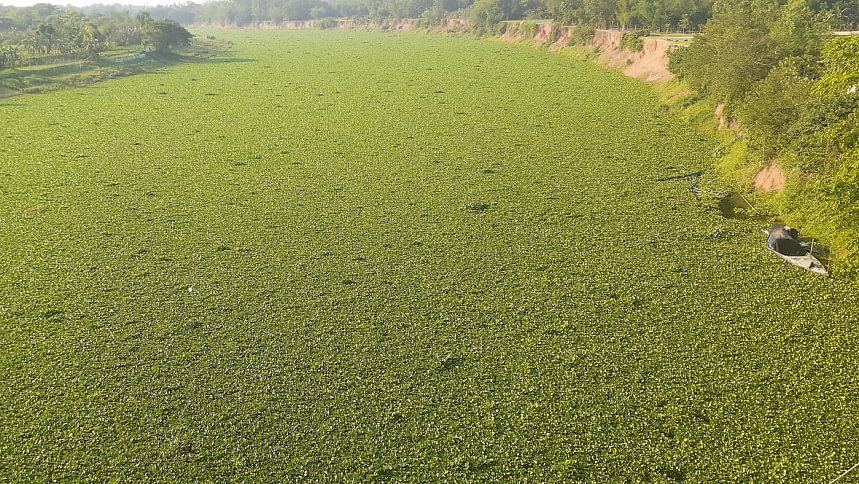Shitalakhhya: Water hyacinth clogging riverways

Sailboats used to ride the waves of the Shitalakkhya river in the past, according to 78-year-old Abdul Gafur Sarker, but all that is visible now is kochuripana, or water hyacinth on the surface of the river.
"The river's surface is now covered in water hyacinth," he said.
"The Shitalakkhya used to be a route for cargo vessels throughout the year, but nowadays it's being hampered due to low navigability as well as abundance of the water hyacinth and other waste in the river," said Gafur, a resident of Mahtabpur village near the river.

The growth of water hyacinth on the water route between Gazipur's Barmi and Narayanganj has caused all forms of transportation to be suspended for the past few weeks, according to local boatmen and boat owners.
At approximately 9:00am on Tuesday, this correspondent visited areas along the river in the Toke and Durgapur union of Kapasia as well as the Barmi union within Sreepur upazila. No boat, trawler, launch, or cargo vessels were seen crossing the Shitalakkhya.
When contacted, Assistant Commissioner (land), Gazipur, Rifat Noor Mousumi, said that as the river's water level rises, less water hyacinth will be present. She said, "It will take two or three months."
"This type of situation has been occurring for the last few years," she said.
Liton Mia, a fertiliser trader near Barmi Bazar, said, "Even five years ago, trawlers or ships full of fertiliser could reach the area. Fertiliser shipments faced obstacles on the water and took a long time to reach us, so the route had to be altered over time. The trucks that carry fertiliser now arrive here much more quickly from the roads.
A boatman named Nurul Islam, 50, claimed that they had ceased operating their vessels because of the water hyacinth's exponential growth.
There were once high and low tides in addition to an overall high water-level. However, the water level has now dropped, he said.
Mobarak Hossain, a bamboo trader, said, "I used to use this route for business, but I don't do it anymore. I could get to Tarabo in Rupganj in five hours by boat. I don't use the waterway because it takes me 14 to 16 hours to get to Tarabo nowadays."
Boat owner Tajuddin Ahmad said, "We have kept our boats anchoured. A few days ago, I went to the river to run my boat, but I had trouble getting it to move. Our boats won't be able to operate unless the water level rises.
Another boat owner, Milon Mia, said, "Right now we are sitting idle. The overabundance of water hyacinths is interfering with our livelihood."
However, Mohammad Nur Hossain, port and transport officer for Bangladesh Inland Water Transport Authority (BIWTA) at Narsingdi's Ghorashal port, said that boats are operating on the water route between Narayanganj and Charsindur as usual.
"We will investigate the matter," he responded when questioned concerning the hyacinth's presence. "Although the route between Barmi and Charsindur is not covered by the BIWTA, we intend to take control of it."
AKM Lutfor Rahman, Upazila Nirbahi Officer of Kapasia, said it was not possible to remove the water hyacinth with the funds from the local administration.
"BIWTA's cooperation is needed to remove these plants," he added.
When contacted, Bejoy Indra Shankar Chakraborty, executive engineer at the Water Development Board's Narshingdi office, stated, "The Shitalakkhya river's navigability was low earlier, but now due to the dredging it has increased. The watercraft can move with ease as a result.
Water hyacinth is extensively used by those who construct enclosures in or near rivers for the purpose of fish farming. In addition to having an adverse effect on the river, fish enclosures in rivers are illegal, he stated.
Fish farmers are occasionally fined by mobile courts. If the number of mobile court proceedings is increased, illegal fish farming can be curbed," he continued.
"Water hyacinth does not stay in one place," he asserted. It moves constantly.

 For all latest news, follow The Daily Star's Google News channel.
For all latest news, follow The Daily Star's Google News channel. 



Comments